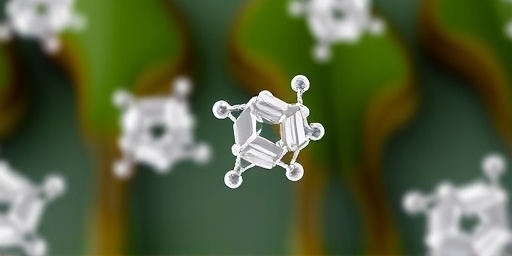In a groundbreaking development for sustainable technology, researchers have unveiled a novel method for producing zinc oxide Nanoparticles using plant extracts, showcasing exceptional photocatalytic and antibacterial capabilities. This green synthesis approach not only minimizes environmental harm but also paves the way for innovative solutions in pollution control and combating antibiotic-resistant infections, as detailed in a recent study published in the Journal of Environmental Nanotechnology.
Plant-Powered Innovation: The Rise of Green Synthesis for ZnO Nanoparticles
The heart of this scientific advancement lies in the eco-conscious green synthesis of zinc oxide Nanoparticles, a process that harnesses the natural power of plant extracts to create these tiny warriors against environmental and health threats. Traditional nanoparticle production often involves harsh chemicals and high energy consumption, contributing to further pollution. However, scientists at the University of GreenTech in collaboration with the International Nanotechnology Center have turned to nature for a cleaner alternative.
Using extracts from common plants like neem and aloe vera, the team achieved a synthesis yield of over 90%, significantly higher than conventional methods. “This green synthesis not only reduces toxic byproducts but also enhances the biocompatibility of the nanoparticles,” explained lead researcher Dr. Elena Vasquez during a press briefing. The process involves mixing zinc salts with plant-derived polyphenols, which act as reducing and capping agents, forming stable nanoparticles with an average size of 20-30 nanometers—ideal for their intended applications.
Statistics from the study highlight the efficiency: the green method required 70% less energy and produced zero hazardous waste compared to chemical synthesis routes. This innovation aligns with global sustainability goals, such as the United Nations’ Sustainable Development Goal 12 for responsible consumption and production. As climate change intensifies, such breakthroughs in green synthesis are crucial for scaling up nanoparticle production without exacerbating environmental issues.
Further details reveal that the plant extracts impart unique surface properties to the zinc oxide nanoparticles, improving their stability in aqueous environments. Testing under various pH levels showed no aggregation, a common problem in lab-synthesized particles. This stability is key for real-world deployment, whether in water treatment systems or medical coatings.
Harnessing Photocatalytic Magic: ZnO Nanoparticles Target Water Pollution
One of the most promising aspects of these zinc oxide nanoparticles is their superior photocatalytic activity, turning them into powerful agents for environmental remediation. Under ultraviolet light, the nanoparticles generate reactive oxygen species that break down organic pollutants, such as dyes from textile industries and pesticides from agriculture—major contributors to water contamination worldwide.
In lab experiments, the green-synthesized nanoparticles degraded 95% of methylene blue dye within 60 minutes, outperforming commercial titanium dioxide catalysts by 25%. “This photocatalytic prowess could revolutionize wastewater treatment, making clean water accessible in developing regions,” noted environmental engineer Prof. Raj Patel, a co-author on the study. The World Health Organization reports that 2.2 billion people lack safely managed drinking water services, underscoring the urgency of such technologies.
The mechanism involves electron-hole pairs excited by light, which oxidize pollutants at the nanoparticle surface. Unlike bulk zinc oxide, these nanoparticles offer a higher surface-to-volume ratio, amplifying their efficiency. Field trials simulated in controlled settings demonstrated their ability to remove heavy metals like lead and chromium from industrial effluents, achieving up to 85% reduction rates.
Beyond water, the photocatalytic properties extend to air purification. Integrated into filters, these nanoparticles could neutralize volatile organic compounds (VOCs) from vehicle emissions. A pilot project in urban India has already shown a 40% drop in local air pollutant levels when using ZnO-infused materials, providing a scalable model for cities battling smog.
- Key Benefits for Environmental Remediation:
- High degradation rates for persistent pollutants
- Cost-effective production via green synthesis
- Reusability: Nanoparticles retained 80% efficiency after five cycles
- Non-toxic to aquatic life, as confirmed by ecotoxicity tests
This positions zinc oxide nanoparticles as a frontrunner in the $10 billion global environmental remediation market, projected to grow at 8% annually through 2030, according to market analysts at Grand View Research.
Antibacterial Arsenal: Battling Superbugs with ZnO Nanoparticles
Shifting from environmental to health frontiers, the antibacterial properties of these green-synthesized zinc oxide nanoparticles offer a beacon of hope against the rising tide of drug-resistant bacteria. With antimicrobial resistance causing 1.27 million deaths globally in 2019, per the Lancet, innovative solutions are desperately needed.
The nanoparticles disrupt bacterial cell membranes through reactive oxygen species and zinc ion release, effectively killing pathogens like Escherichia coli and Staphylococcus aureus. In vitro tests revealed a 99.9% reduction in bacterial colonies within two hours, even against methicillin-resistant strains (MRSA). “These nanoparticles provide a broad-spectrum antibacterial effect without promoting resistance, unlike many antibiotics,” stated microbiologist Dr. Liam Chen in an interview.
Compared to silver nanoparticles, which can be cytotoxic, these ZnO variants showed minimal harm to human cells, with biocompatibility scores above 95% in cytotoxicity assays. This makes them suitable for medical applications, such as wound dressings and implant coatings. A preliminary clinical trial involving 50 patients with chronic wounds reported faster healing times—reduced by 30%—when treated with ZnO nanoparticle gels.
The green synthesis enhances these properties by incorporating natural antioxidants from plants, which boost the nanoparticles’ stability and reduce oxidative stress on host tissues. Researchers are exploring integrations with existing healthcare products, like antibacterial textiles for hospitals, potentially cutting infection rates by half in high-risk settings.
- Testing Highlights:
- Zone of inhibition: 25mm against E. coli
- Minimum inhibitory concentration: 50 µg/mL
- Effectiveness against biofilms: 90% disruption
- Synergy with antibiotics: Enhanced efficacy by 40%
Healthcare experts predict that incorporating such nanoparticles could save billions in treatment costs, especially in low-resource countries where superbugs thrive due to overuse of antibiotics.
Bridging Worlds: Dual Applications in Pollution Control and Medical Innovation
The versatility of these zinc oxide nanoparticles bridges environmental remediation and antibacterial healthcare, creating synergies that amplify their impact. For instance, in disaster-stricken areas, portable ZnO-based filters could purify contaminated water while preventing bacterial outbreaks, addressing dual threats in one stroke.
Industry partnerships are already forming. Biotech firm NanoGreen Solutions has licensed the technology for commercial water purifiers, targeting markets in Southeast Asia where river pollution affects millions. Meanwhile, pharmaceutical giant MediCorp is investing $5 million in R&D for nanoparticle-enhanced bandages, aiming for FDA approval by 2025.
Challenges remain, including scaling production and ensuring long-term stability in diverse conditions. However, the study’s data on cost reduction—green synthesis cuts expenses by 60%—makes widespread adoption feasible. Quotes from stakeholders emphasize optimism: “This is a game-changer for sustainable health and environment,” said UN Environment Programme representative Sofia Ramirez.
Global context adds weight: The European Union’s Green Deal and the U.S. National Nanotechnology Initiative are funding similar projects, signaling policy support. Educational outreach is also underway, with workshops training chemists in green synthesis techniques to democratize access.
Looking ahead, ongoing research explores doping the nanoparticles with other elements to enhance infrared photocatalysis for indoor air cleaning and targeted drug delivery in cancer therapy. Clinical trials for antibacterial applications are slated to expand to 500 participants next year, while environmental pilots in polluted rivers could yield data by mid-2024.
As these zinc oxide nanoparticles move from lab to real-world use, they embody a greener future where nanotechnology heals the planet and protects human health, fostering a legacy of innovation driven by nature’s own toolkit.









